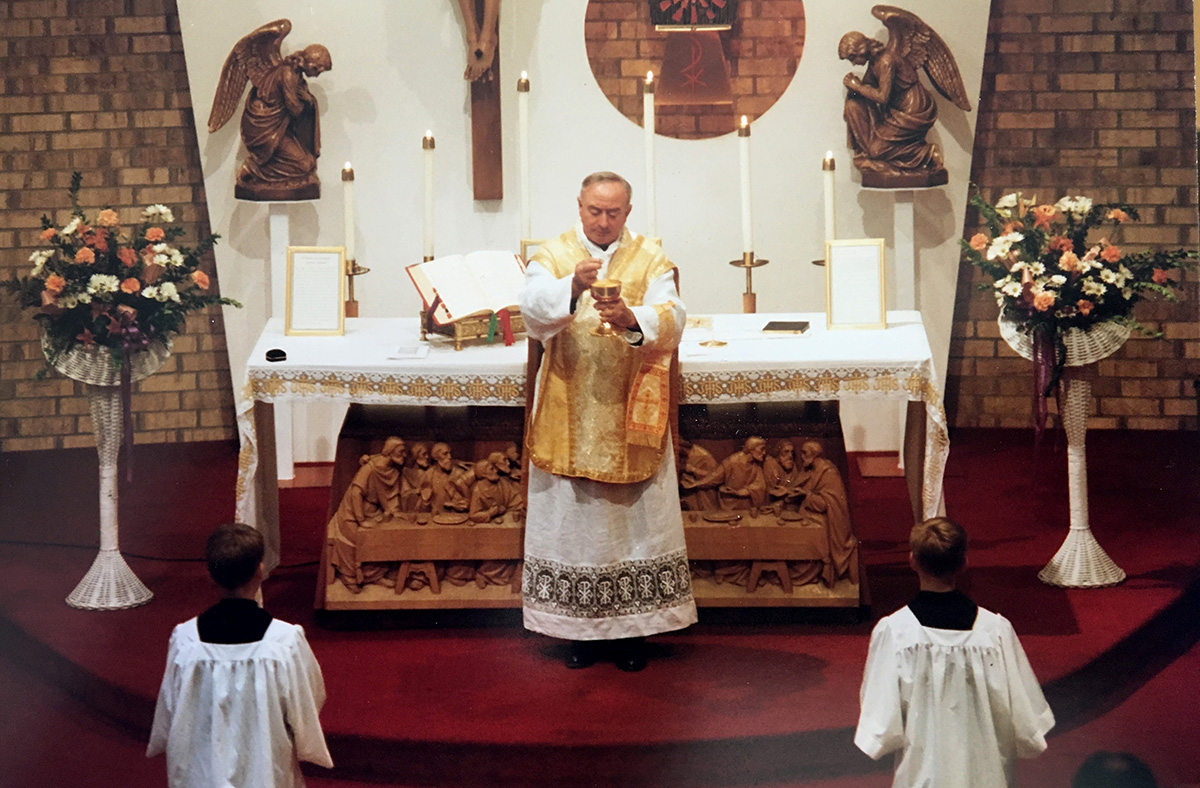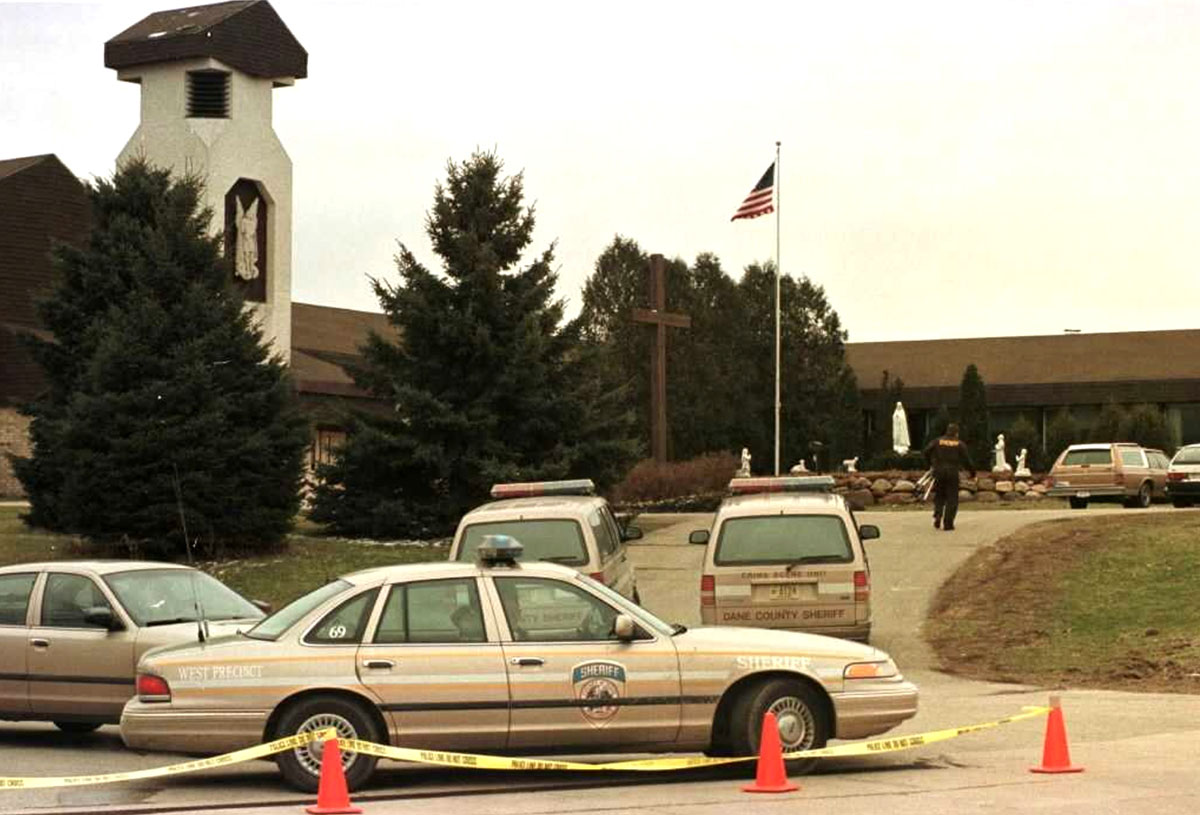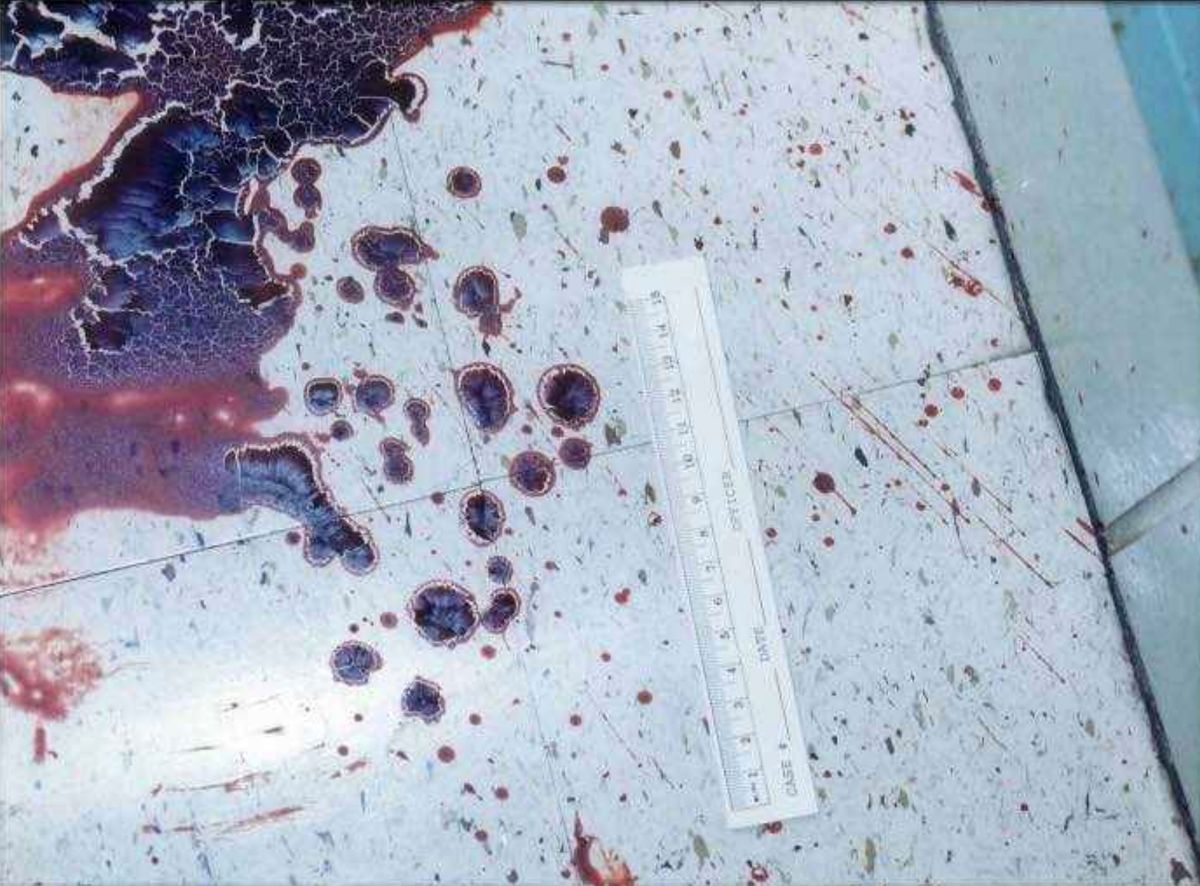Bury the Dead
By Gina Barton
Kunz was ordained in 1956 and celebrated his first Mass at the church he attended as a child, St. Mary’s in Fennimore.
Less than 10 years into his priesthood, the Catholic Mass was transformed. For centuries, the church had followed age-old traditions. When Kunz was growing up, Masses everywhere, from his home parish in Wisconsin to the grand cathedrals in Europe, were said in Latin. Priests in elegantly embroidered robes prayed with their backs to the congregation. Choirs sang in the ancient language of the liturgy, at times filling the sanctuary with Gregorian chants. In the early 1960s, Pope John XXIII led the church into the modern age by calling for a series of conferences that came to be known as Vatican II. It had been nearly 100 years since the first Vatican Council. Back then, the church formally adopted the concept of papal infallibility, meaning the pope alone has the final say on Catholic doctrine. Vatican II took place from 1962 to 1965. During the meetings, 2,000 church leaders worked together to produce a series of documents that laid out new rules for the Mass, the religious lives of priests and Christian education, among other things. Priests were instructed to celebrate the Mass in the language of the people, facing the congregation. Use of the old Latin rite was discouraged, although it could still be used on some occasions. Kunz became pastor of St. Michael in 1967. At first, he embraced the new ways, wearing plaid robes as a ukulele sometimes took the place of the organ. He gained a position on the marriage tribunal in Madison, where he helped decide which divorcing couples deserved annulments and which ones did not. Read the documents When St. Michael was struck by lightning and burned to the ground in 1974, Kunz led the charge to raise funds and rebuild. The new church featured up-to-date architecture and decor. He chose contemporary stained-glass windows depicting colorful barns and pine trees instead of Biblical scenes. As the years passed, Kunz had a change of heart. He lost the respect of church leaders as a result. Forgotten amid the updates of Vatican II, he came to believe, were 2,000 years of history. Contemporary touches such as jazz music, he once said, robbed the Mass of its sacredness. Embracing them was a serious sin that could lead straight to hell. Kunz didn’t make the list of priests authorized to say the Mass in Latin, but he did it anyway. Whenever he walked toward the front of St. Michael at the beginning of a service, he kept his head down. Approaching the altar of the Lord, Kunz kept his eyes focused on the ground, ashamed to look up at the stained-glass windows, symbols of the time he’d lost his way. Although Kunz also said Masses in English, St. Michael soon became known for his traditional Latin services, offered three mornings a week for the schoolchildren and once on Sundays. Some people would make a pilgrimage faithfully every weekend, driving 100 miles or more from Illinois and Iowa. To them, Kunz was the holiest of men. To the rest, the hierarchy in Madison and believers who accepted the changes of Vatican II, Kunz had become a cleric stuck in the past, a malcontent to be avoided and ignored.
When Dane County sheriff’s investigators began their search for Kunz’s killer, they first tried to answer the most basic of questions: Why was he murdered? Because of the tenets Kunz preached and the way he lived, the answers have remained elusive for more than 20 years. Kunz was a man of contradiction. He instilled a fear of damnation in the afterlife, yet he tried to make peoples’ time on Earth easier by handing out cash to those who needed it — men and women, church members and not. He banished those who questioned his authority, yet he left the church doors unlocked for strangers seeking shelter. He preached strict adherence to the Ten Commandments, yet detectives investigating his death spoke with at least two women who said they’d had sexual contact with him. In passionately following church teachings about performing both corporal and spiritual works of mercy — bury the dead, instruct the ignorant, feed the hungry — Kunz often came into contact with people on the fringes of society. Many of them grew to love the priest, but almost any of them, police believed, also could have killed him. The effort to catch the priest’s killer began with dozens of Dane County sheriff’s department staffers working the case full time. State investigators and the FBI were called in. They formed teams that tried to systematically rule out motives and suspects. But as the investigation wore on, police instead found themselves with a growing list of possible perpetrators: a teacher who quarreled with Kunz over work, an ex-con who needed money, a man who feared the end of the world. After about two years, the investigation stalled. Continuity disappeared as the sheriff’s department assigned new detectives to the case every few years. Over the past two decades, five different people have served as lead investigator. The case file consists of thousands of pages — and counting — snapped into 40 three-ring binders. The sheriff can’t name anyone working for the department today who has read them all. And the knife the killer used to slit Kunz’s throat has never been found. That doesn’t mean the detectives’ work over the past 20 years hasn’t produced some solid leads. It has. It has also resulted in a defense attorney’s dream: A list of possible suspects, each with at least one investigator who believes wholeheartedly in his or her guilt. As a result, if anyone is ever charged, the defense would have ready-made reasonable doubt to present to jurors.
A few years ago, using updated technology, analysts at the state crime lab found new trace DNA evidence. Detective Gwen Ruppert, who has led the investigation for the past six years, believes it likely came from the killer — although it’s possible there is some other explanation. Where was the new evidence found? On Kunz’s hands? Under his fingernails? On his collar or his belt buckle? Ruppert would say only that it was somewhere significant, somewhere the killer would have had reason to touch. Even if the police were certain this DNA came from the killer, it wouldn’t be enough to solve the case. For one thing, there’s no way to tell when it got there. What’s more, scientists were able to create only a partial profile, with too few points of comparison for an upload to the national FBI database. Visual comparisons at the state lab showed the new sample doesn’t match any of the suspects whose DNA has been collected over the years. That isn’t 100 percent proof of their innocence, but it was enough to make Ruppert set them all aside and concentrate on following new leads. As recently as two years ago, after getting a promising tip, a team of six detectives and a clerical staffer spent months focused solely on the Kunz case. On the 20th anniversary of the murder in March 2018, the sheriff’s department launched a social media campaign designed to elicit new information. View key locations Ruppert and Dane County Sheriff David Mahoney, who was a detective back in 1998, said mistakes in the investigation may have made it harder to catch the killer. Police allowed Maureen O’Leary, the principal at St. Michael, to remove Kunz’s Rolodex from his office. Back then, before cellphone contact lists and friends on social media, the Rolodex would have been the only place for the police to find the names and numbers of everyone close to Kunz. No one currently employed at the sheriff’s department knows why O’Leary wanted the Rolodex. The police never got it back. Without it, they were unable to complete one of the most fundamental tasks of a murder investigation: compiling a timeline of how the victim spent his final hours. The missing Rolodex also might have helped police uncover the details of a heated phone conversation overheard in the school the morning before Kunz was murdered. The person who heard it couldn’t tell who the priest was talking to. Technology at the time didn’t allow the phone company to identify the number after the fact. Asking everyone in the Rolodex when they’d last spoken with Kunz could have helped them identify the caller, who might also be the killer. Another set of missteps concerned the treatment of teacher Brian Jackson, the man Cattanach saw outside the school with blood on his hands. Police never impounded Jackson’s car or searched it for trace evidence. Within hours of the murder, he was able to drive it out of the school parking lot. One detective who worked on the case for years, Kevin Hughes, set his sights on Jackson and refused to glance in any other direction. Ten years ago, Hughes’ lieutenant told reporters they knew who the killer was, but the district attorney wouldn’t charge him. Their attempts to build a case against Jackson rather than remaining open to other theories may have allowed valuable clues to go unnoticed, according to the sheriff. Jackson shares that view. “Honestly I wish they’d stop barking up this tree,” he told the Journal Sentinel last fall. “I think that’s what waylaid them.” Due to the new DNA evidence and an analysis of the 911 call, Jackson has since been ruled out as a suspect, according to Ruppert. Mahoney still thinks the priest’s murder can be solved. “It could very well be somebody who's been carrying this information for 20 years and it's probably weighed heavily on them,” he said. “If the offender is Catholic and is still alive — and even if they went to confession — I'm not so sure that it's not burning in their soul.” Ashley Luthern of the Journal Sentinel staff contributed to this report. How we reported this story In reporting this story, Milwaukee Journal Sentinel reporter Gina Barton conducted dozens of interviews with those involved in the case. She attended the 20th anniversary Requiem Mass for Father Alfred Kunz and visited the Queen of the Holy Rosary Mediatrix of Peace shrine in Necedah, Wis. The Dane County Sheriff’s Department declined to release its case file to the Journal Sentinel, citing an exemption to the state’s public records law for open cases. Barton reviewed 50 pages of department reports that had been released to the Journal Sentinel in 1998 and remained on file in the newsroom. Those reports document the initial police response to the 911 call and several interrogations of Brian Jackson and people who knew him. Barton read court records, archival records detailing events at the shrine and portions of Malachi Martin’s book on exorcism, “Hostage to the Devil.” She also reviewed dozens of print and television news reports about the Kunz homicide and investigation. In addition, Barton listened to seven and a half hours of the “Our Catholic Family” and “Our Apostolic Church” radio programs. Recordings of the programs were provided to the news organization by Peter Kelly, who produced them. Descriptions of Kunz’s feelings, beliefs, experiences and teachings were taken from statements he made on the show in 1997 and early 1998. Father Charles Fiore also spoke on some of the recordings. Details and quotes in scenes were obtained through interviews with those present or from police reports, court records, transcripts, archived news reports, video recordings or audio recordings. Brian Jackson spoke briefly in person to Journal Sentinel reporter Ashley Luthern. He said he is innocent and believes the investigation was waylaid by the fact detectives spent so much time on him. He declined a detailed interview, saying his lawyer had advised against it. Jackson’s thoughts, feelings and interactions with Kunz, as conveyed in the story, come from police reports in which he described them to detectives. In all other instances in which people’s thoughts are described, they conveyed those thoughts to a reporter. Throughout the series, quotation marks indicate a subject’s exact words as written in a transcript, as recalled by a party to the conversation or as stated to a reporter, either now or at the time of the incident. Italics indicate statements recalled or summarized by a third party in an interview, a news story or an investigative document, such as a police report. People who provided information for this chapter include retired deputy David Cattanach, former sheriff Gary Hamblin, Detective Gwen Ruppert, Sheriff David Mahoney and Father Scott Jablonski, the current pastor of St. Michael Church. Retired Detective Linda Pederson Honer said in an interview that she personally interviewed two women who admitted having sexual relationships with Kunz, but she would not give their names. Retired Detective Kevin Hughes lives in Ecuador and could not be reached. A relative provided email addresses for Hughes and his wife, but he did not respond to multiple messages. Maureen O’Leary did not respond to phone messages, knocks on her door or a letter.
|
.
Any original material on these pages is copyright © BishopAccountability.org 2004. Reproduce freely with attribution.



